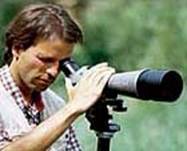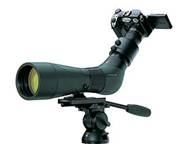 |
The latest digital cameras have paved the way for a new way to capture that close up photograph of a rare bird – digiscoping. A special adapter allows you to attach a digital camera (still or movie) to your telescope. The results can be amazingly good and essential for identifying a real rarity. Telescopes or scopes as they are often called, vary in quality between models and manufacturers. Some are available with either standard or high definition glass but whichever one you choose it will make little or no difference to its suitability for digiscoping. However, you may notice some image quality differences as the high definition scopes produce a crisper, cleaner image with reduced colour fringing. |
Getting started – the essentials
- Telescope
- Digital camera
- Adapter to connect the scope and camera
- Adequate sturdy but dark coloured tripod
- Cable release
- Computer with picture manipulation software
Useful accessories
- Spare batteries or a battery pack
- Spare memory cards
- Magnifier and/or monitor shade
- Scope cover
- Imaging software package such as Photoshop
|
Telescope

|
It is not so much size that matters. it is the quality that really counts. Big is not always best. Spend your money on the optics and you will rarely be disappointed. Additional features such as rubber armouring and waterproofing will help to reduce wear, tear and the occasional knock. |
Camera
In the beginning, just a few years ago, the Nikon Coolpix range was the camera of choice for most birders turned digiscopers, especially the Coolpix 4500. Increasing numbers of suitable cameras are now becoming available. Some scope manufacturers also supply cameras.
Good results are also coming from recently released ranges of tiny lightweight cameras, but they are limited by their choice of settings and availability of suitable accessories for digiscoping. Some of the latest small DSLR (Digital Single Lens Reflex) cameras are also producing some excellent pictures. SLR cameras allow you to look through the lens so you can see precisely what you are photographing. This is particularly useful for close up photography. An additional technique for DSLR cameras is to mount the camera without its lense directly onto the scope, which also has its eyepiece removed. This eliminates the problem of vignetting. |
 |
Cable release
The image is magnified through the scope, so too will any movement of the camera and lens. To minimise camera shake which can result in blurred photographs, use a cable release.
Adapter
Adapters are now available to fit every scope. Keeping the camera and lenses as close to each other as possible reduces or eliminates vignetting, (dark corners appearing on your picture). |
Battery
Always carry a spare fully charged battery, especially if out of reach of a charging supply for more than a few hours. Although the energy consumption of the latest digital cameras is more efficient, they are by nature of running LCD screens and zoom lenses, very power hungry.
Memory Card
Most cameras come supplied with a memory card but it is seldom enough, particularly when travelling. Always carry at least one spare with the biggest memory capacity you can afford.
Monitor shade of magnifier
Even the brightest LCD screen is not easy to see on a sunny day. Solve the problem by using a magnifier to get your eye close to the screen or use a simple sunshade. |

